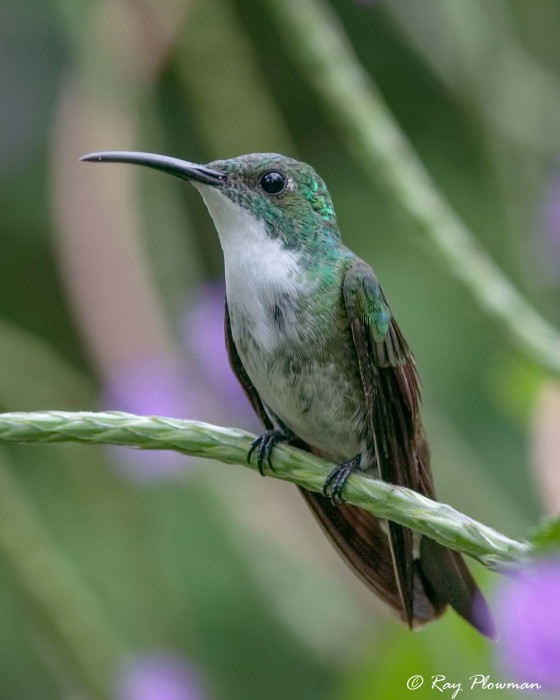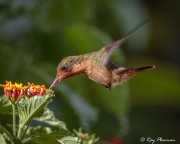Hummingbirds and Relatives
The gallery features Hummingbirds (Trochilidae) photographed in Ecuador and Trinidad; the latter is geographically part of South America and unlike most Caribbean islands. These birds are amongst the smallest; are highly specialised often seen hovering around flowers to feed on nectar. A second gallery shows portrait and behaviour photos of the Oilbird (Steatornithidae), Nightjars (Caprimulgidae) and Potoos (Nyctibiidae). The final gallery displays hummingbird behaviours such as perched at rest, flying, and hovering and feeding on nectar.
Hummingbirds
Hummingbird Notes
All the species shown in the galleries are ‘Red List 2019’ assessed as ‘Least Concern’. I photographed them in forest and garden habitat at Asa Wright Nature Centre in Trinidad’s Northern Range and Ecuador. Asa Wright has several walking trails, a large garden with Vervain shrubs and Mimosa trees that attract some species of hummingbird.
Hummingbirds present a challenge to photograph as they flap their wings at around 50 to 70 beats per second; the resulting noise this makes gives them their name. They can fly at 25-30 mph (40–50 kph), dive at 60 mph (95 kph), hover and fly forwards and backwards. The smallest of the six species that I photographed was the Tufted Coquette, which is about 5 cm to 7 cm, weighs less than 3 g and the largest a Black-throated Mango at 11 cm and weighing mere 7 g.
Most hummingbirds have pigmentation feathers and iridescent feathers, making up their plumage resulting in brilliant colours. These colours are the result of light diffraction, which changes with both viewing angle and lighting conditions. Iridescence often results in the metallic sheen. At certain aspects, the gorget (throat feathers) appear black with no reflected light but as the viewing angle changes the refracted light becomes visible, resulting in a shimmering iridescent display. Images in the photo galleries below show iridescent throat feather effect for both the Tufted Coquette and Ruby Topaz. Only the male hummingbirds have brilliant iridescent throat feathers, which they use for display.
The Oilbird, Nightjars and Potoos
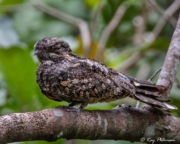
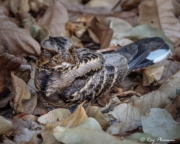
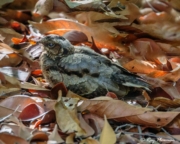
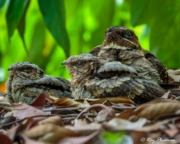

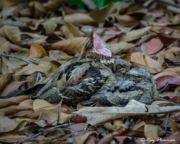
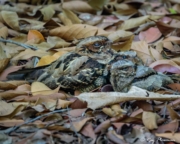
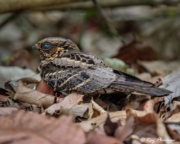
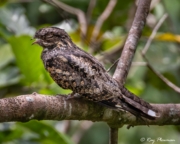
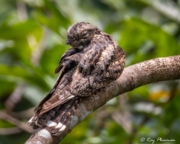
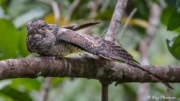
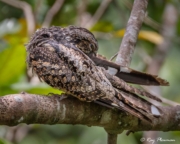
Oilbird, Nightjar and Potoo Notes
Displayed species in the gallery are ‘Red List 2019’ assessed as ‘Least Concern’. The Oilbird, Nightjar and Potoo are nocturnal birds, resting and sleeping during the day. The monotopic Oilbird is the only member of the Steatornithidae family. Asa Wright Nature Centre and Lodge run guided tours for residents to Dunston Cave, home to an Oilbird colony. Oilbirds use echolocation clicks to find their way around in the dark. Photography is challenging as the cave is very dark; only one or two people can see into the cave at any one time. I had to use high ISO without flash.
Both featured nightjars are sexually dimorphic: males have white spots on the outermost primary wing and tail feathers while the female spot colour is buff. I spent a couple of hours at Jelutong Tower in Singapore’s Central Catchment Reserve waiting for birds to visit and photographing the Grey Nightjar perched high up in the canopy. The pictures feature behaviours such as dozing, stretching, and changing its position along a tree branch. Quite pleased to get some shots where the feet are visible, and tail and wing colouring was visible. My first sighting and photos of a Large-tailed Nightjar is a family group of an adult and two checks in Singapore Botanic Gardens.
The Common Potoo is a member of the Nyctibiidae family which I photographed late evening in Trinidad’s Caroni Swamp.
Hummingbird Behaviours
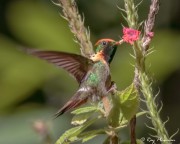
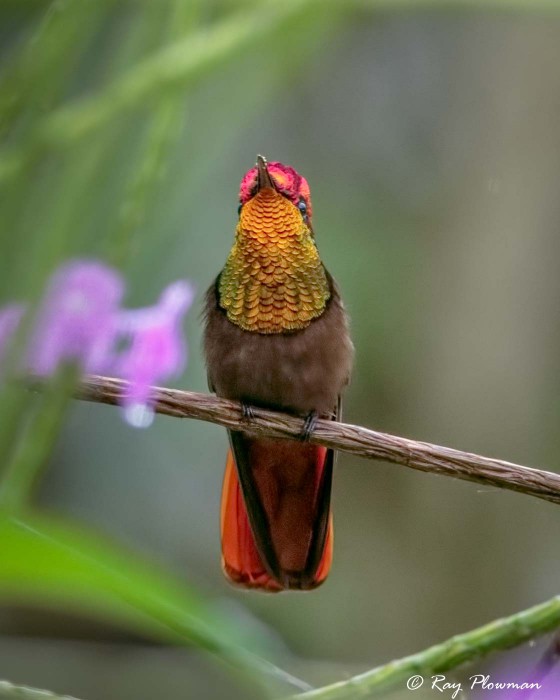
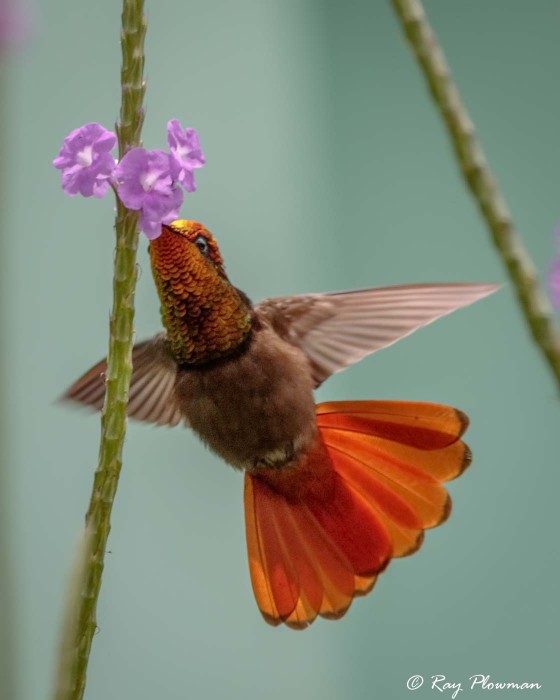
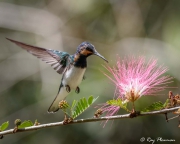
Tufted Coquette
I photographed both male and female Tufted Coquette feeding on the nectar of mauve and purple-flowered snakeweed and red-flowered changeable velvetberry. The male Tufted Coquette has a shaggy crest with orange check feathers; the female is less spectacular, lacking both the crest and orange check feathers. Despite their speed and size, these little birds soon became my favourite to photograph. It was more challenging to find them perched than flying.
Snakeweed (Stachytarpheta jamaicensis) is a Caribbean native plant while changeable velvetberry (Stachytarpheta mutabilis) is an introduced species, both are part of Verbenaceae family.
Ruby-topaz
I found an area in Asa Wright Nature Centre (AWNC) garden where a Ruby-topaz visited in the late morning and early afternoon to feed on purple snakeweed. With patience and returning frequently, I was able to capture a few images of the birds feeding, flying, and perched at rest.
White-necked Jacobin and White-chested Emerald
The White-necked Jacobin was a frequent visitor to nectar feeders on the veranda at AWNC, at 11 cm was one of the largest I encountered. I was pleased to capture an immature male White-necked Jacobin feeding on mimosa flowers.
White-chested Emeralds are smaller being 9.5 cm, seen perched on vervain and feeding on yellow flowers. It’s the only non-sexually dimorphic species I photographed.
Yellow sanchezia (Sanchezia parvibracteata) is a tropical South and Central American native plant from Acanthaceae family.
Blue-chinned Sapphire and Black-throated Mango
These two species were elusive, so I only have a few images of them and only one image of a perched Black-throated Mango. The Blue-chinned Sapphire was visiting yellow flower sanchezia at AWNC’s garden to feed.
Taxonomic Note
The Strisores clade contains five Aves orders; the album displays images from four:
(a) Apodiformes (Hummingbirds and Relatives) has five family members, including Hummingbirds (Trochilidae). Trochilidae splits into five subfamilies, three feature in the gallery.
(b) Caprimulgiformes (Nightjars) family Caprimulgidae,
(c) Nyctibiiformes* (Potoos) family Nyctibiidae,
(d) Steatornithiformes* (Oilbird) family Steatornithidae with only one species in the order/family.
The taxonomy of this clade is open to interpretation with proposed changes such as to merge Apodiformes with Caprimulgiformes. The asterisk (*) indicates orders which show in the IOC Order of Birds as members of the Caprimulgiformes (Nightjars), superorder Caprimulgimorphae.









